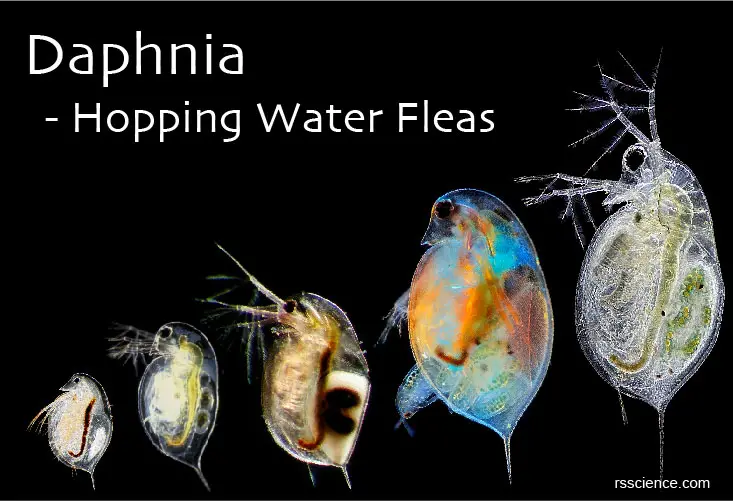This article covers
What is Daphnia? A quick overview
Daphnia is a genus of small planktonic Crustaceans under the Arthropoda Phylum. The body of a Daphnia is usually 0.2–6.0 mm (0.01–0.24 inches) long, which is pretty tiny compared to its cousins such as crab, lobster, crayfish, and shrimp. Daphnia species live in various aquatic environments ranging from acidic swamps to freshwater lakes and ponds. Daphnias are also called water fleas because their swimming style resembles the movements of fleas.
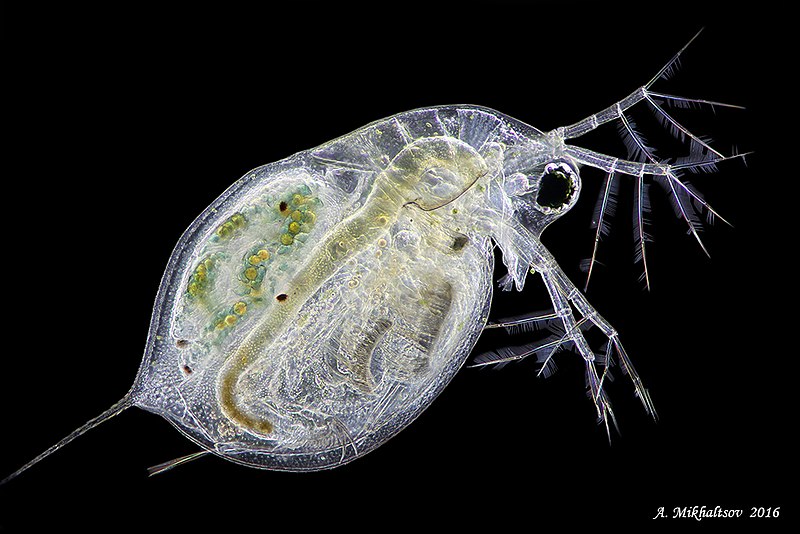
[In this image] A dark-field microscopic image of a Daphnia.
Image source: Wikimedia commons
[In this video] See microscopic crustaceans like Daphnia, Copepod, and Ostracod under the microscope.
Classification of Daphnia – the Phylum Arthropoda
Scientific classification
Kingdom: Animalia
Phylum: Arthropoda
Subphylum: Crustacea
Class: Branchiopoda
Order: Anomopoda
Family: Daphniidae
Genus: Daphnia
Daphnia is a member of Phylum Arthropoda. Arthropods are invertebrate animals having an exoskeleton, a segmented body, and paired jointed appendages (legs). Insects, spiders, scorpions, centipedes, mites, crabs, shrimps, daphnias, copepods, and trilobites (extinct) all belong to the enormous family of Arthropoda. Arthropoda owns the largest number of species among animals. They are very successful both on land, in water, and in the air.
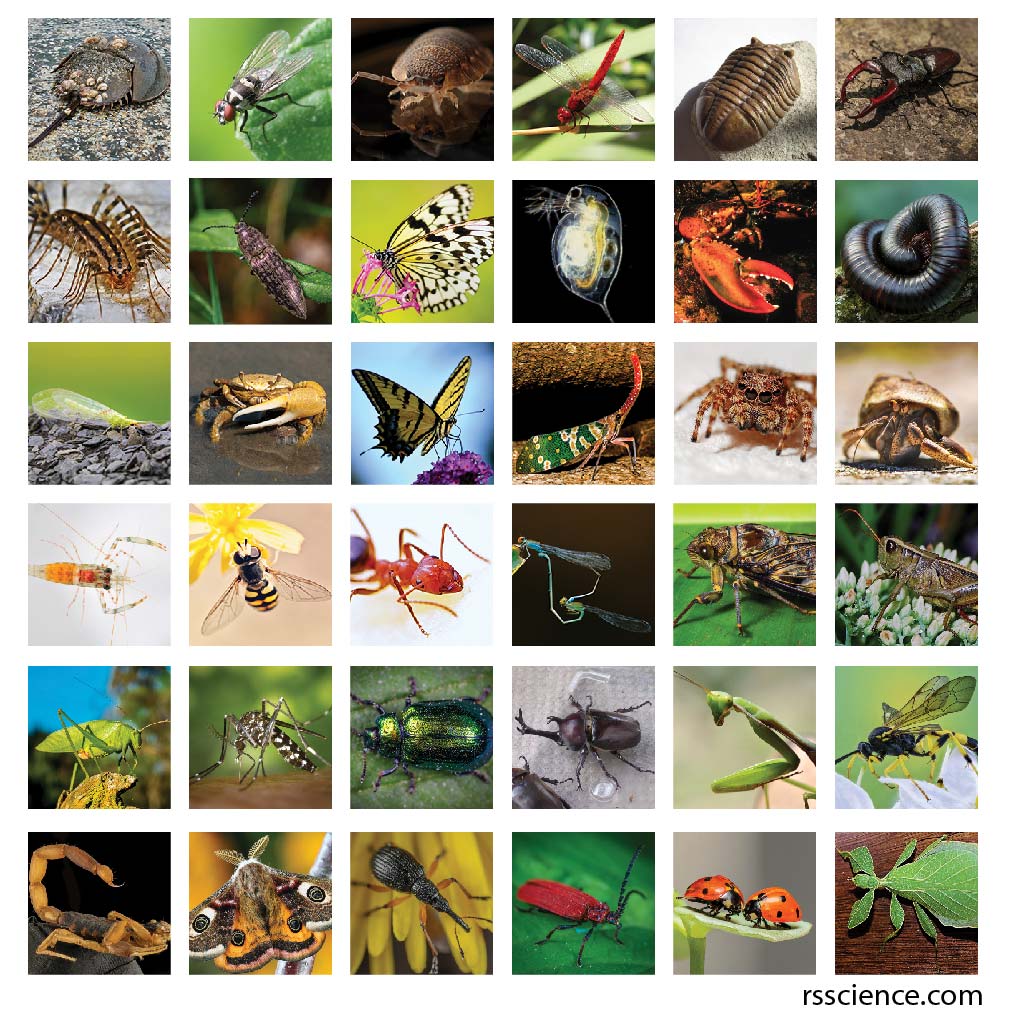
[In this image] The huge family of Arthropods.
Daphnias can be classified under a subphylum called Crustacea. Crustaceans form a large, diverse group of aquatic animals such as crabs, lobsters, crayfish, shrimp, krill, prawns, woodlice, barnacles, copepods, amphipods, and mantis shrimp.
There are about 450 species of Daphnias distributed worldwide. The two most commonly found species are D. pulex (smaller and most common) and D. magna (larger). D. pulex is a biological model species and was the first crustacean to have its genome sequenced.
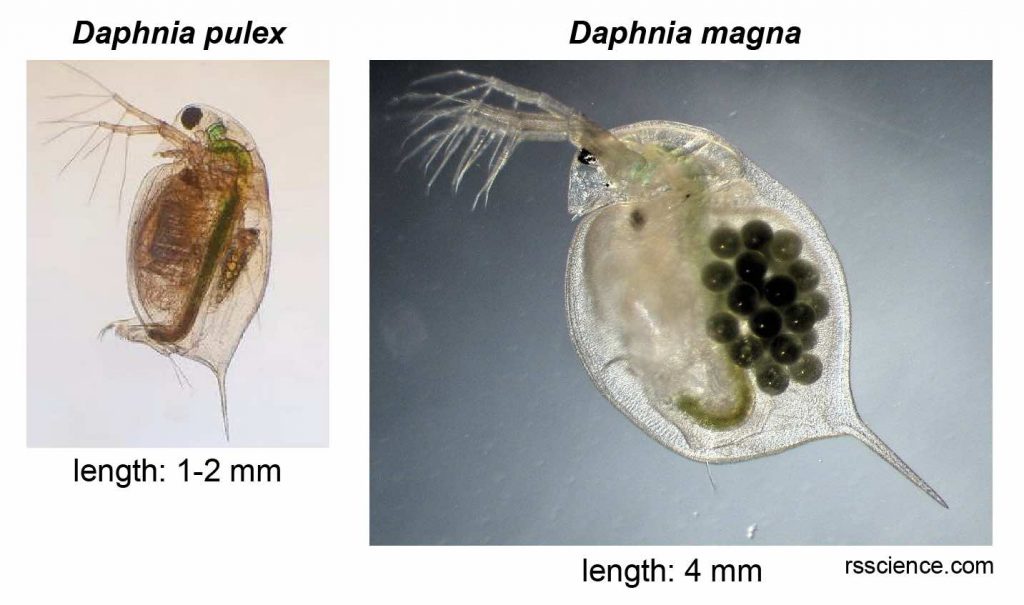
[In this image] Two most common Daphnia species. Left: D. pulex with a body length around 1-2 mm. Right: a female D. magna with a clutch of eggs. It can grow up to 4 mm long.
Original images: D. pulex, D. magna
Where do Daphnias live?
Daphnias can be found in almost every nutrient-rich water body. A few species are marine, but generally, most Daphnias are freshwater organisms (in lakes and ponds).
Daphnias may move between different depths of the water column. They can move up to the algae-rich surface of the water (usually at night) and move down to the bottom of lakes to avoid predators (during the day). Their location is also controlled by seasonal variations depending on their food supply.
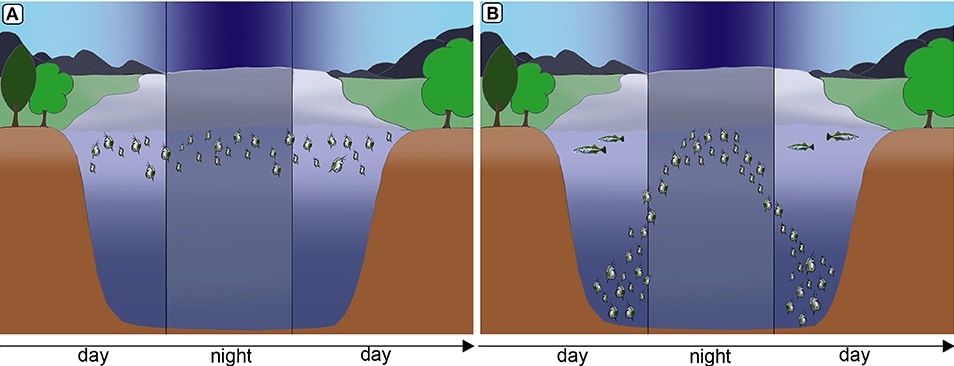
[In this image] Diel vertical migration of Daphnias.
Daphnias are smart and can learn how to avoid fish predation. (A) Daphnias remain in warm, nutritious water near the top layer of open water in the absence of predators. (B) Under predation, Daphnias migrate to deeper water strata, seeking refuge from fish predators. However, they migrate to nutrient-rich and warmer strata for feeding during the night.
Image source: Weiss LC., Front. Behav. Neurosci., 2019
Why we call Daphnia a planktonic animal?
Daphnias are too small and weak to live in a strong current, which they are unable to swim against. But they are light enough to stay suspended by using their legs and antennae for movement. This is why we classify Daphnia as a “planktonic animal”, meaning they live mainly by drifting in the body of water.
We usually call all these planktonic animals drifting in oceans, seas, and freshwater “Zooplankton”. In Greek, zoon means “animal” and “planktos” means “wanderer” or “drifter”. Zooplankton includes single cellular protozoa, small crustaceans, and some juvenile mollusks, shrimps, crabs, or fishes. Zooplankton is the fundamental food source in a food chain, which plays a critical role in aquatic ecology.
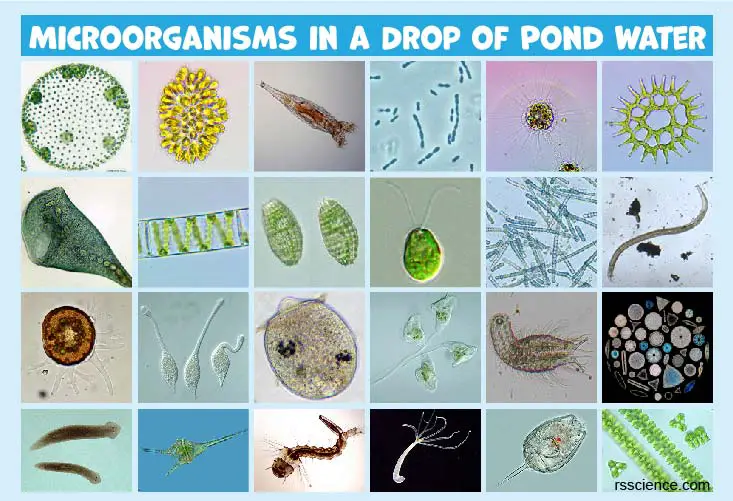
[In this image] Many microscopic organisms constitute the fundament of the food chain in a water body. Daphnias feed on algae or bacteria. Then, they in turn are eaten by fish and aquatic insects. It seems that their role in life is to provide a snack for a larger organism.
Click the post below to learn more about different microscopic organisms in a drop of pond water.
The body structure of Daphnia
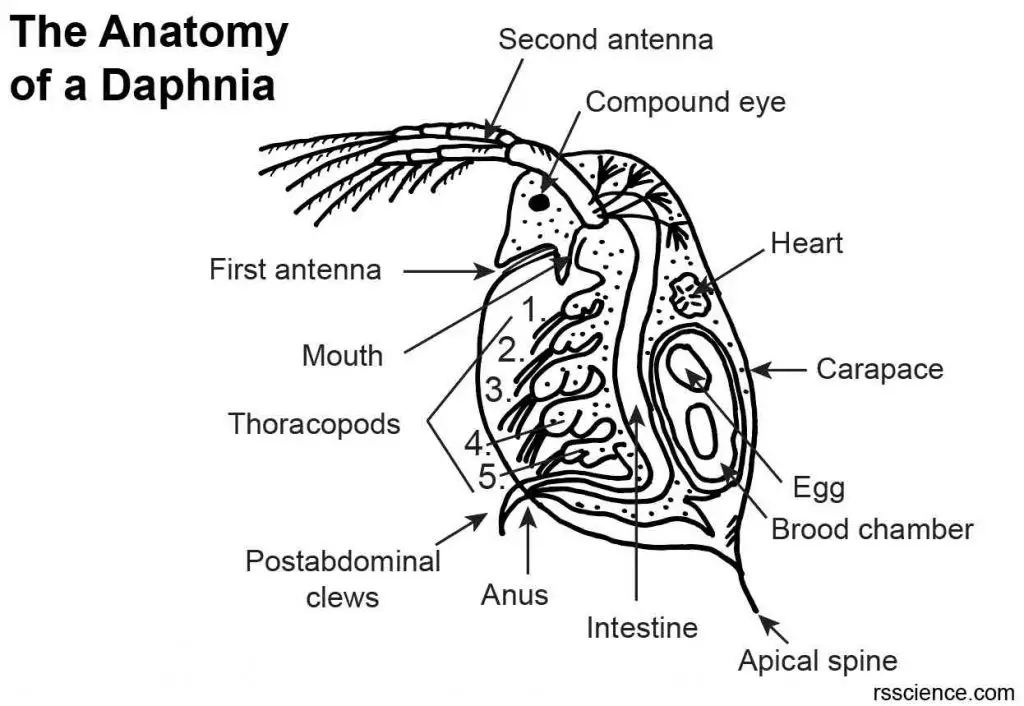
[In this image] An illustration of body parts of a Daphnia pulex.
Studying the anatomy of Daphnia is made easier by the fact that most of its outer shell is clear, showing most of the internal organs at work, including the beating heart.
[In this image] Daphnia magna under the microscope.
Carapace or shell
Daphnia’s body is divided into segments (a common feature of Arthropods), although this division is not visible. Its body is covered by the two-valved carapace, a folded shell-like structure protecting its back. This exoskeleton is made up of chitin and calcium.
There is an abdominal gap of the carapace, in which the five or six pairs of legs lie. Overall, a Daphnia looks like a short and stout shrimp without body segments.
Head, compound eyes, and antennae
The head of a Daphnia contains a pair of darkly colored compound eyes and numerous antennae used for feeling and swimming. The number of ommatidia (or small eyes) that make up the compound eye varies from species to species – some species could have up to 300 ommatidia! Daphnia’s eyes can move by the ciliary muscles.
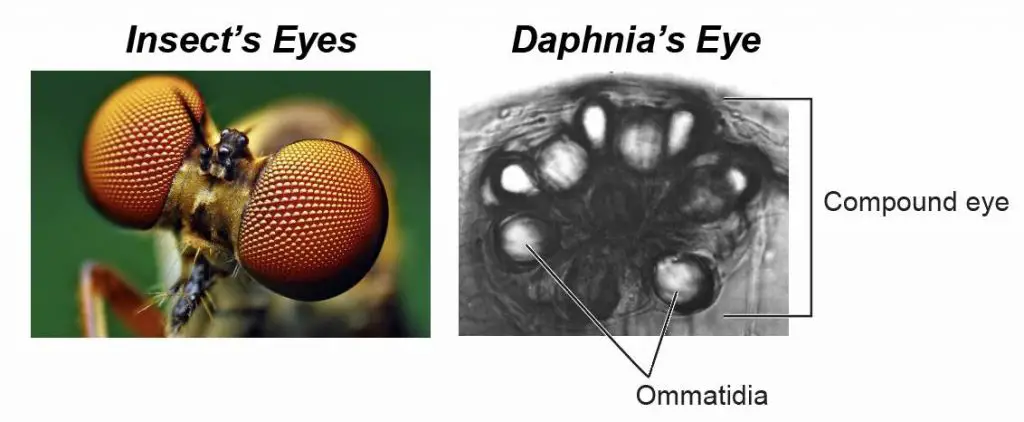
[In this image] The comparison of compound eyes from a fruit fly and a Daphnia. Each compound eye consists of many ommatidia – from hundreds (insect’s eyes) to 20 (Daphnia’s eyes).
Image source: Left, Moment of Science; Right, Semantic scholar
The first antenna is smaller and located close to its mouth, which creates a motion bringing the food particles into the month. The second antenna is much bigger and used for swimming. Each of the second pair of antennae has two branches, and both branches bear long, feathery bristles.
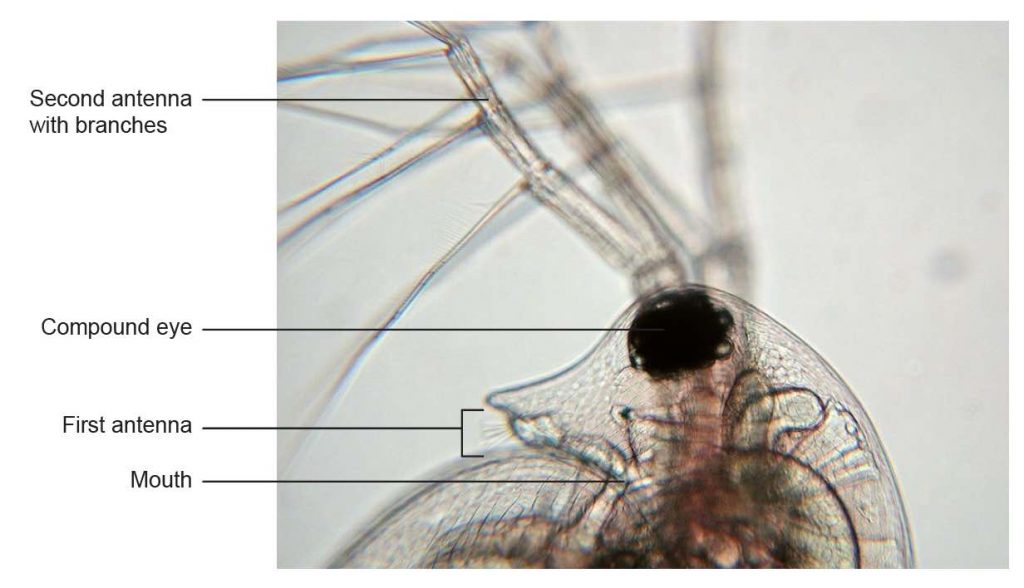
[In this image] Zoom in to see the detail of Daphnia’s head.
Image source: New World Encyclopedia
Body
The thorax of water fleas is very short and hard to tell. There are five or six pairs of thoracopods (or thoracic appendixes) on its abdominal side, which move like the rows of legs under a shrimp.
Daphnia has a primitive digestion system, including the mouth, intestine, and anus. Near its anus, Daphnia uses two hook-like cuticular claws (postabdominal claws) to clear debris out of the carapace.
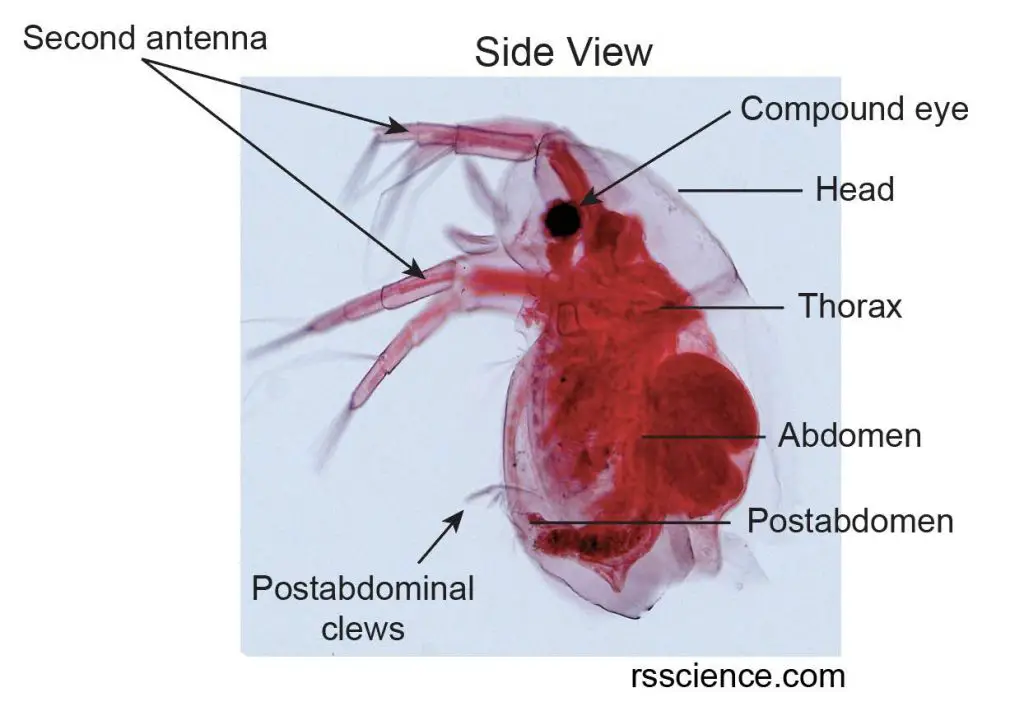
[In this image] A mounted Daphnia pulex, which was stained with a red dye, shows you its side view.
Heart
Daphnia’s heart is at the top of the back, just behind the head. Under normal conditions, it can beat at an average heart rate of 180 beats per minute.
[In this video] Heart beating of a Daphnia.
Daphnia has an open circulatory system. Instead of having blood vessels, Daphnia has a fluid called hemolymph and blood cells. Under a microscope, you can even see blood cells being pumped throughout the body cavity by the simple heart.
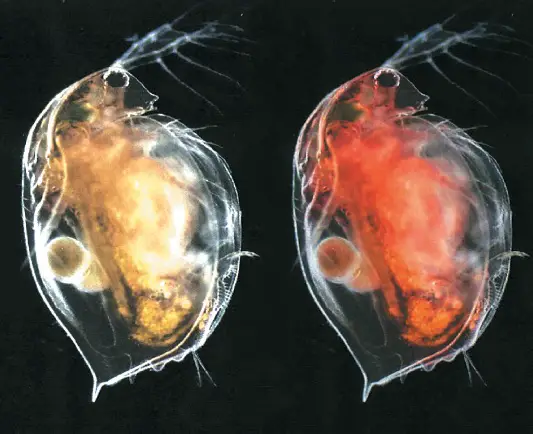
[In this image] Daphnias can produce hemoglobin to adapt to low-oxygen environments. Pale (left) or bright red (right) Daphnia, depending on whether they live in O2-rich or O2-poor water. The color change reflects how much hemoglobin the animals are synthesizing.
Image source: Shinichi Tokishita
Nervous system
Daphnia’s nervous system consists of a brain and paired nerve cords. Like many animals, Daphnia’s nervous system can be affected by chemicals. Due to the translucent shell and the visibly altered heart rate, scientists performed many experiments on Daphnia to study the increase in the heart rate by giving Daphnia alcohol, caffeine, nicotine, or adrenaline.
Reproductive system
Daphnia males are generally smaller than females but have longer antennae and a modified postabdomen. Daphnia females have a brood chamber located between the body wall and dorsal surface of the carapace used to carry their eggs.
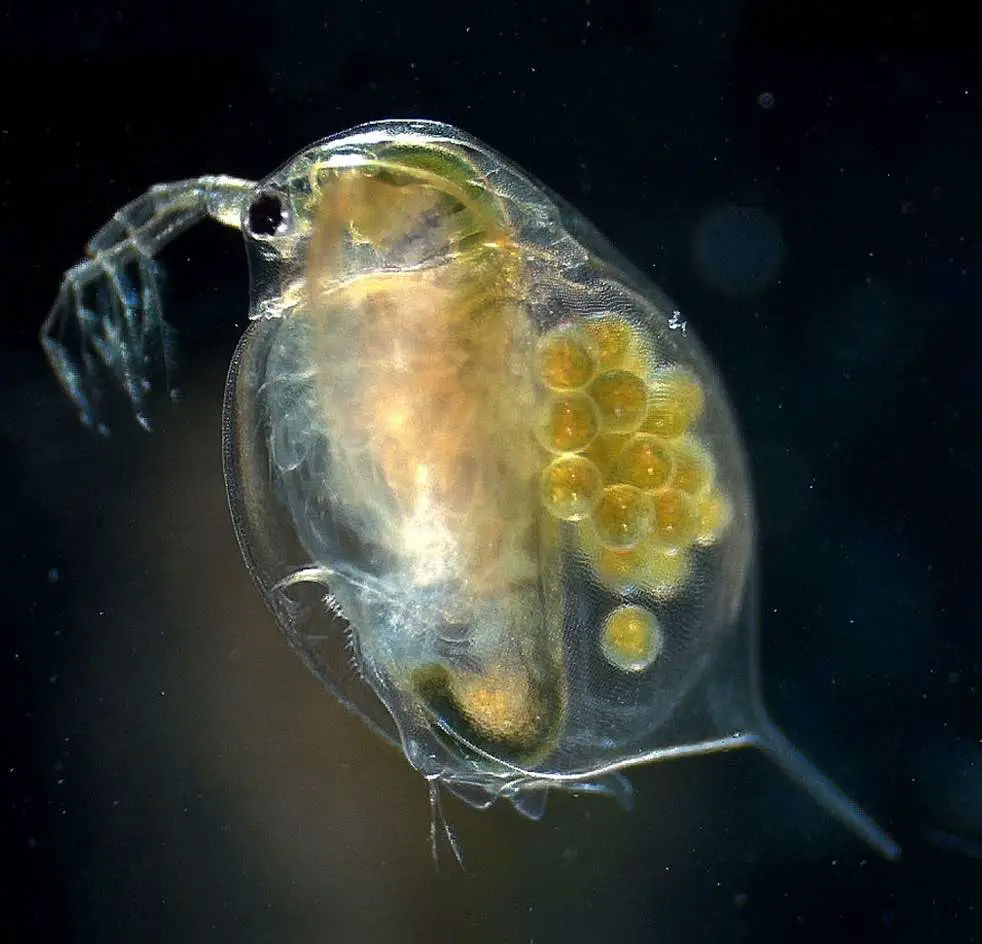
[In this image] A female Daphnia with eggs. Its carapace is nearly translucent, so we can observe the internal organs, including the heart, intestine, and eggs under the microscope.
Image source: wiki
How does a Daphnia eat?
Daphnias are filter feeders, meaning that they do not actively seek food. As they swim, they filter even tinier organisms from the water. They feed on single-celled algae, yeasts, and bacteria. They also eat small organic particulates from decomposed plants.
Daphnias are often used to clean fish tanks of algae “bloom” because their diet consists of very small algae particles. A few bigger Daphnia species are carnivorous and prey on other water fleas.
How does a Daphnia swim?
Daphnias are also called common water fleas because of their general appearance and jerky hopping motion which resembles that of the land fleas. Swimming is powered mainly by the second set of antennae, which are larger in size than the first set.
[In this video] Water fleas (Daphnia sp.) swimming like hopping.
Daphnia’s life cycle and reproduction
Under favorable environmental conditions (usually in the spring until the end of the summer), Daphnias reproduce parthenogenetically to expand their population rapidly. Parthenogenesis is a form of asexual reproduction in which the offspring develop from unfertilized eggs. Parthenogenesis is common in insects and spiders, and also occurs in some species of fish, amphibians, and reptiles.
One female Daphnia can carry 50 or so eggs in the brood chamber. These unfertilized eggs are nurtured in the brood chamber inside the mother Daphnia’s carapace. The newly hatched Daphnia babies must molt several times before they are fully grown. This process usually takes about two weeks.
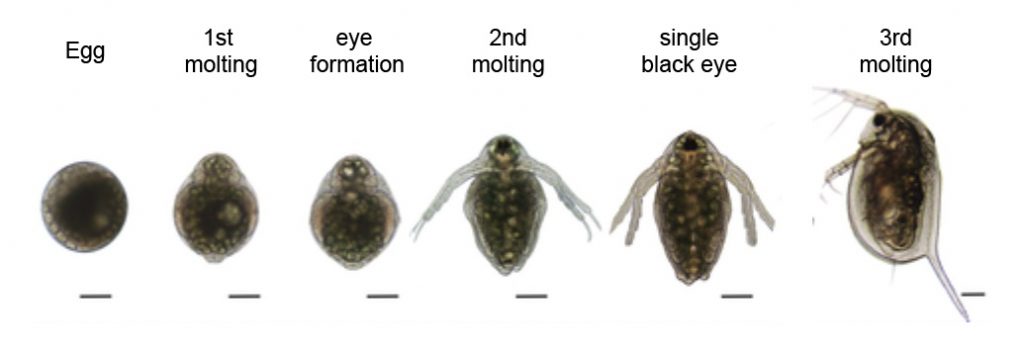
[In this image] Inside the mother Daphnia’s brood chamber, new Daphnias grow by molting. When they are released, the young ones are fully grown small copies of the adult.
Image source: modified from Sumiya E. et.al., J of Applied Toxicology, 2016
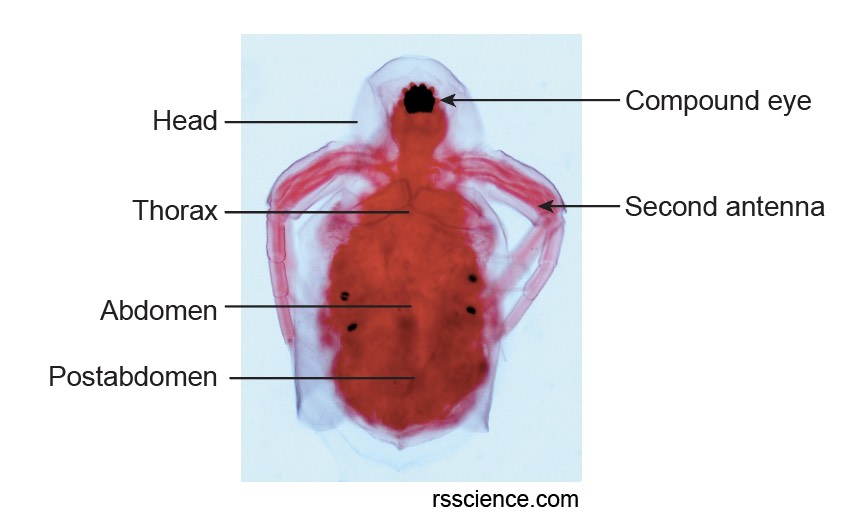
[In this image] A stained Daphnia pulex juvenile has a single compound eye.
Fully mature females can produce a new brood of young about every ten days under ideal conditions. The reproduction process continues while the environmental conditions continue to support their growth.
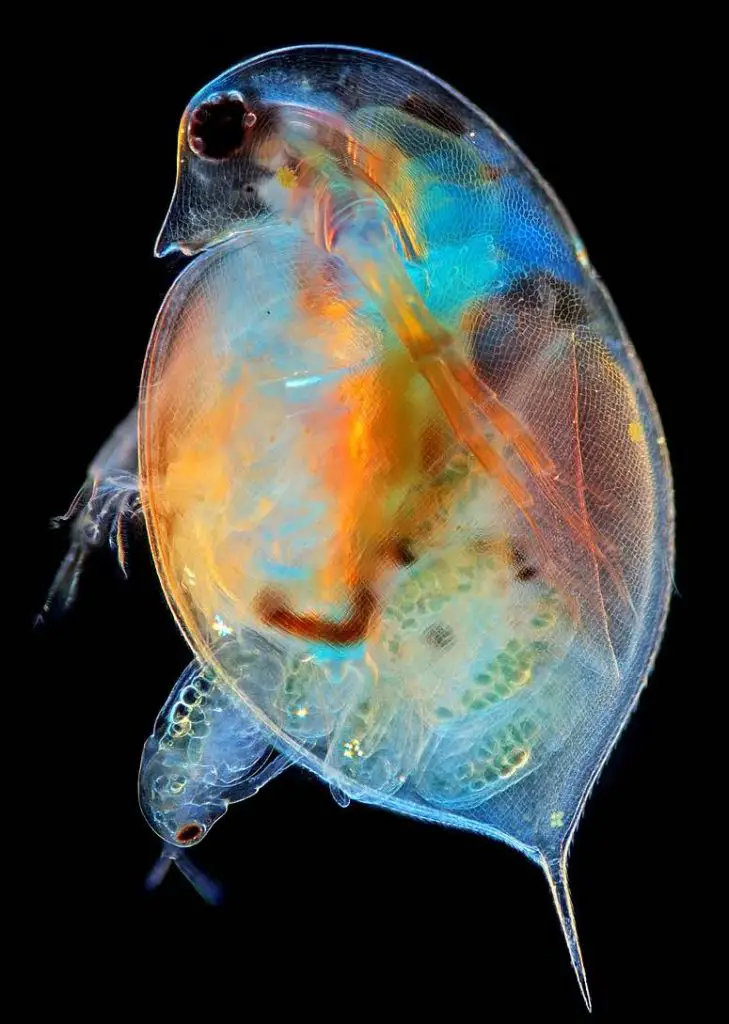
[In this image] A Daphnia giving birth to young Daphnia.
Image source: wiki
When winter or other harsh environmental conditions approach, the parthenogenetic reproduction ceases, and male Daphnias are produced. Males tend to be much smaller in size than females. However, even in harsh environmental conditions, males may make up considerably less than half the population. Sexual reproduction by mating generates fertilized eggs, also called winter eggs, and are provided with an extra shell layer called ephippium. The extra layer preserves and protects the egg inside from harsh environmental conditions until the more favorable times, such as spring when the reproductive cycle can take place once again.
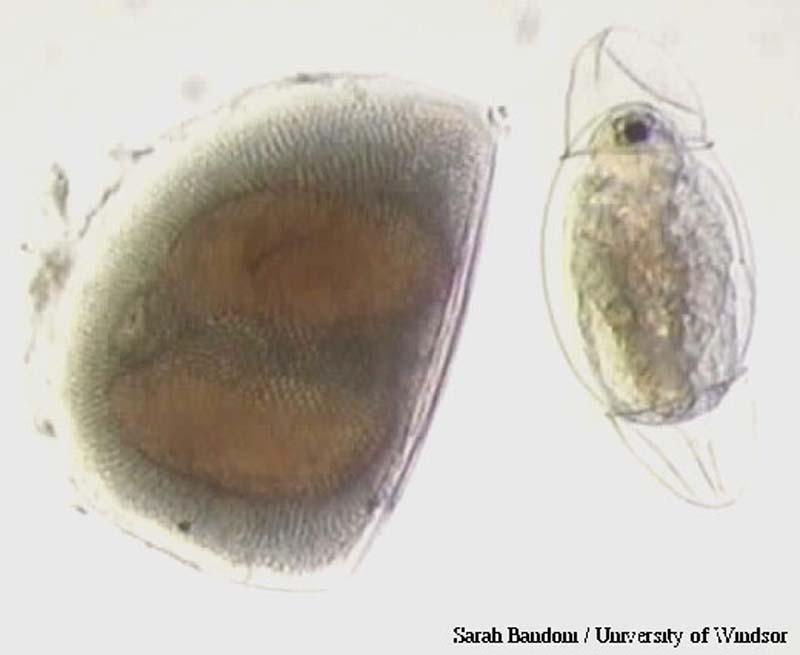
[In this image] Resting egg pouch (ephippium) and the juvenile Daphnia that just has hatched from it.
Image source: wiki
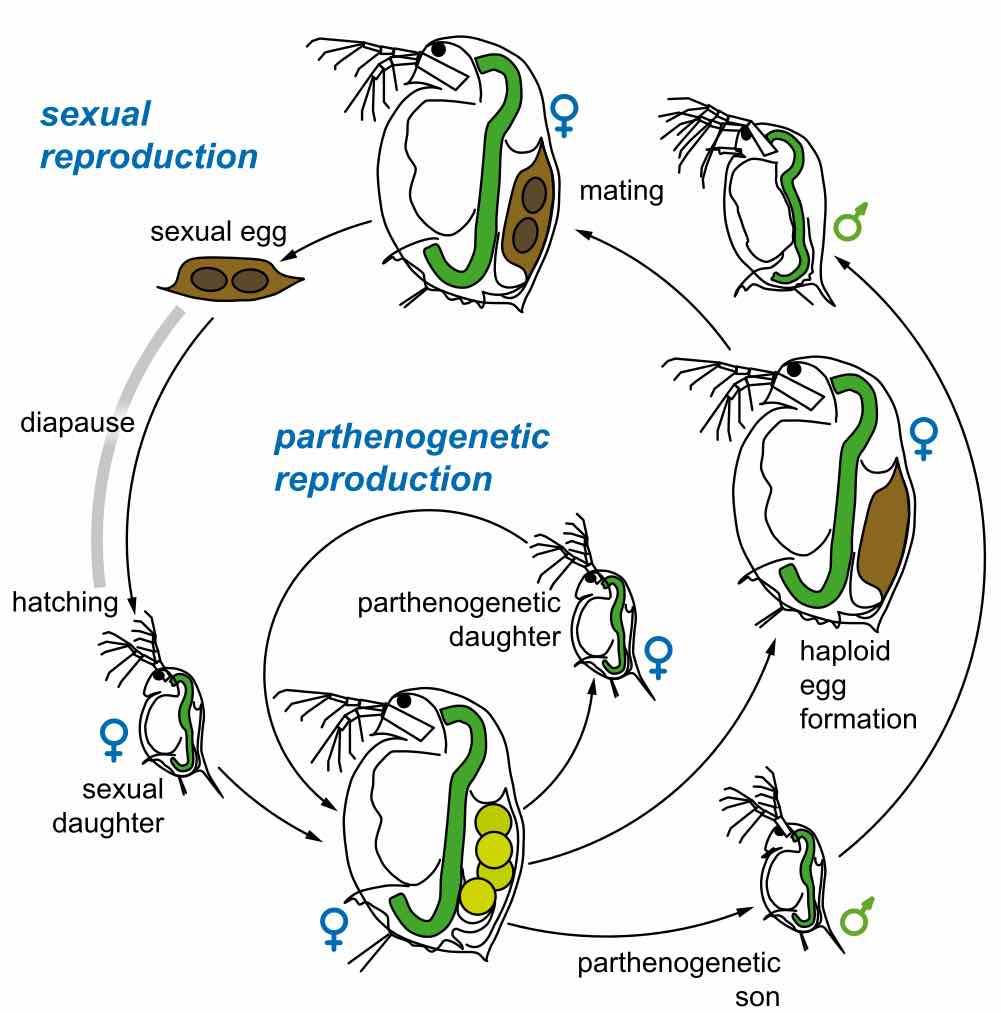
[In this image] The life cycle of Daphnia magna – The decision to go through either parthenogenetic or sexual reproductions is made based on environmental conditions.
Image source: wiki
How does a Daphnia grow?
Like all Crustaceans, Daphnia’s shell cannot grow, so they need to molt as the animal grows larger. Because the carapace is used for protection, a new shell is usually grown under the old for the organism to be shielded at all times. The old carapace is discarded, and the animal rapidly absorbs water into the new shell, producing a stage of very rapid growth called an instar. This is especially prominent in juveniles, which can double their size from one instar to the next. The absorbed water is later gradually replaced by tissue.
[In this video] Daphnia’s ecdysis or molting.
Notice the big one coming out of its carapace.
Daphnias are amazing transformers!
Daphnia can also avoid predators in a process called Cyclomorphosis in which it changes its size and shape to be more difficult to be eaten. The size is often predator-specific as they become larger or smaller to avoid consumption by the many types of fish that use Daphnias as their primary food source. A decrease in size is common when levels of the adult fish population are high, making the Daphnia harder for the larger organisms to see. Similarly, an increase in size is common when the levels of juvenile fish are high, making the Daphnias more difficult for these smaller fish to eat.
Several other environmental factors can also trigger cyclomorphosis, including the seasonal change of water temperature, sun period, current turbulence, and food abundance. Some Daphnia species can totally change their shape and elongate their body by extending the head to form a helmet and increasing the apical spine length.
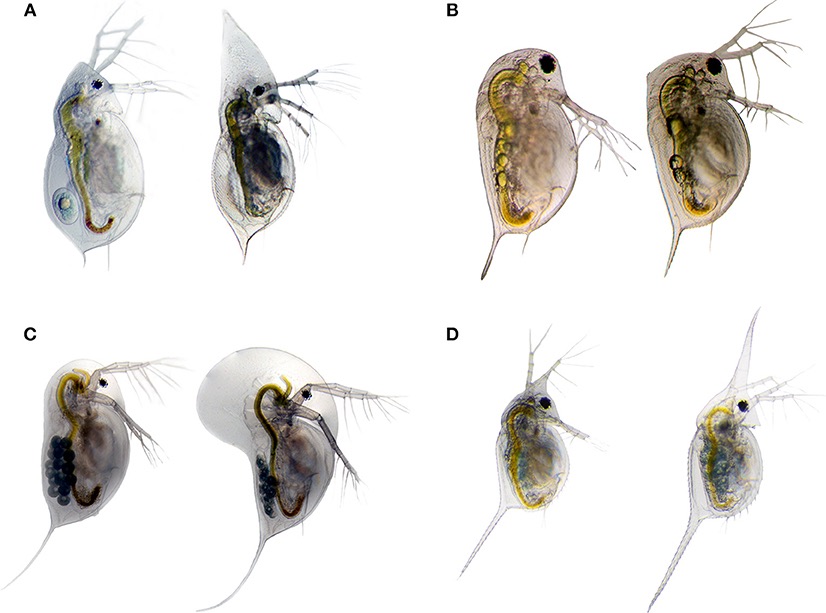
[In this image] Four paired of Daphnias showing the morphological defenses by cyclomorphosis. Undefended morphotypes are displayed on the left side, and the defended morphotypes on the right side. You can see they are growing structures like a helmet or spike to make the predators hard to eat them.
Image source: Weiss LC., Front. Behav. Neurosci., 2019
The importance of Daphnias
Daphnias are a popular live food in tropical and marine fish keeping. Ecologically, Daphnias are at the bottom of the food chain pyramid, consuming algae and bacteria, and then being prey for small fish and carnivorous aquatic insects. The population of Daphnias is routinely used to measure the healthiness of aquatic habitats. For example, due to the sensitivity of water temperature, Daphnia is an indicator species commonly used to test climate change aspects.
Daphnias also make model organisms for biological study. The translucent carapace makes them excellent subjects for the microscope as one can observe the beating heart. As we mentioned above, scientists had used Daphnia to study several chemicals and observe an increase in heart rate.
[In this video] Even under relatively low-power microscopes, the heart beating of a Daphnia can be easily observed. Scientists took this advantage and used Daphnia to study the effects of Caffeine on the heart rate of Daphnia magna.
Daphnia’s short reproductive cycle of only 8-10 days makes it ideal for experimental genetics. Many laboratories are studying the functions of genes and the evolution among arthropods using Daphnia’s genome. Daphnia pulex was the first crustacean to have its genome sequenced. Its genome contains 31,000 genes – 8,000 more than the human genome (~ 25,000 genes)!
Daphnia even has a parasite disease. A bacterial parasite called Pasteuria ramosa infects Daphnia magna and transmits within Daphnia’s population.
Summary
1. Daphnia is a genus of small planktonic Crustaceans under the Arthropoda Phylum. Its body is usually 0.2–6.0 mm long and is enclosed in a transparent shell. Daphnias are also called water fleas because their swimming style resembles the movements of fleas.
2. Daphnias are filter feeders, meaning that they do not actively seek food. As they swim, they filter single-celled algae, yeasts, and bacteria.
3. Daphnia’s body is divided into segments. It has a transparent carapace (shell), head, compound eyes, antennae, heart, intestine, nervous system, and reproductive system.
4. Under favorable environmental conditions, Daphnia produces their progeny through asexual reproduction in which the offspring develop from unfertilized eggs (Parthenogenesis). When winter or other harsh environmental conditions approach, sexual reproduction occurs. Mating generates fertilized eggs, which also contain an extra shell layer to protect the egg inside from harsh environmental conditions until the more favorable condition comes.
5. Daphnia avoids predators by changing its size and shape, a morphological defense called cyclomorphosis.
6. Daphnias are a popular food for tropical and marine fish. They are at the bottom of the food chain pyramid, consuming algae and bacteria. Daphnia is an indicator species commonly used to test climate change aspects.
7. Daphnias is a good model organism for biological study. The translucent shell makes them excellent subjects for the microscope because we can observe the beating heart. Scientists had used Daphnia to study several chemicals’ impact on heart rate.

